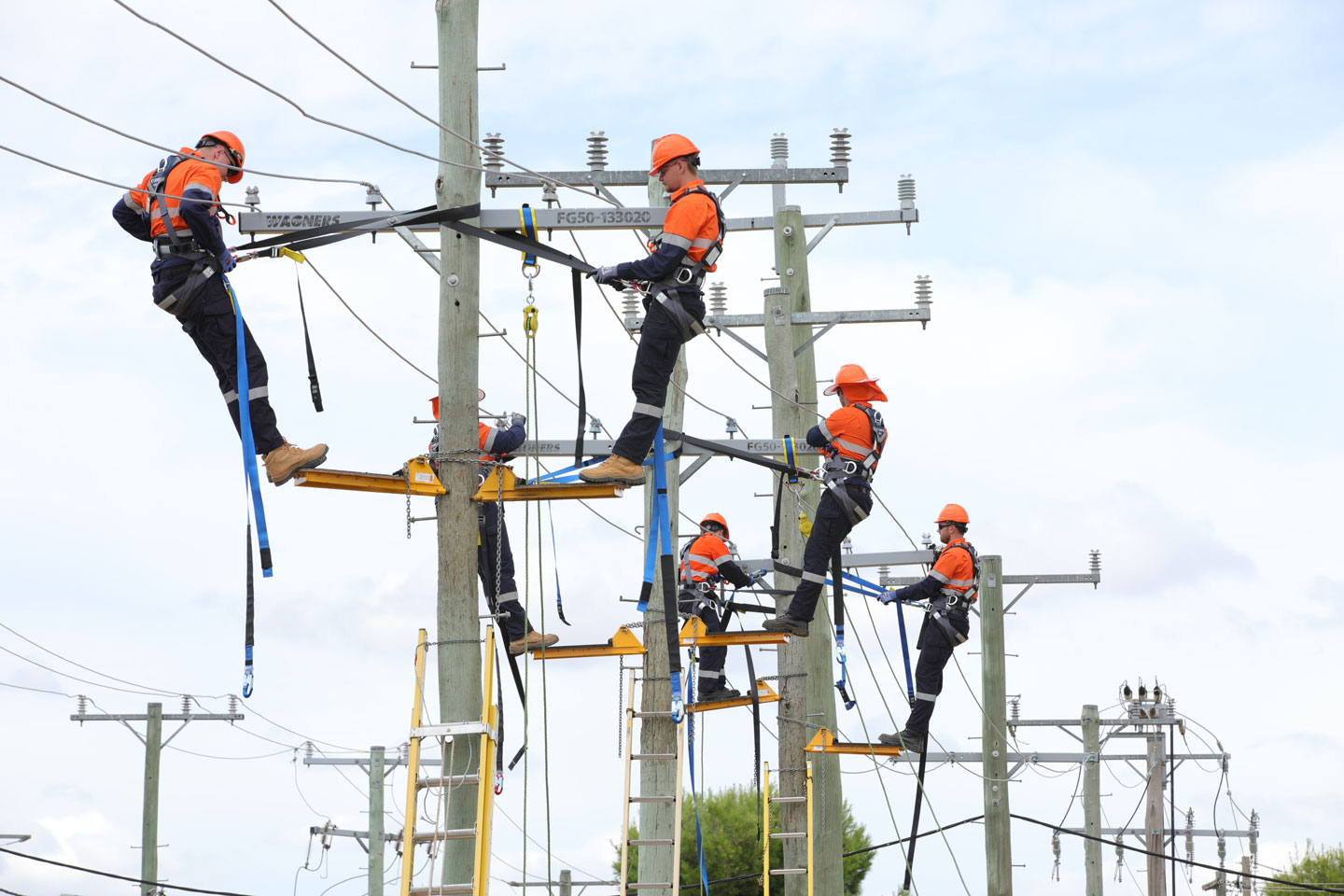Sustainability Strategy and Governance
Our Sustainability Strategy guides our approach to generating positive value for our customers, our community and our people. We are committed to supporting the transition to a net zero economy while continuing to provide an accessible, reliable and resilient energy supply.
The strategy integrates with our Corporate Strategy and builds on a strong foundation of sustainability-related activities. Over the past year it has helped us address our most pressing sustainability issues.
Our sustainability pillars
Pillar 1. Responding to climate change
Our commitments
We are facilitating the transition to net zero by optimising network connections and decarbonising our operations. We are supporting electrification, including electrifying our fleet and leveraging renewables.
As climate events are increasing in frequency and severity, our first priority is to minimise disruptions during a crisis by building resilience, future-proofing assets and providing our customers with alternate energy solutions.
Outcomes delivered
The number of renewable generation connections to our network continued to grow significantly over the past year. Renewables delivered more than 31 per cent of total network load – continuing the year-on-year growth over the past decade (see figure 1 below). The total capacity of connected large-scale renewables was 1.35 GW, and 1.56 GW for small-scale renewables.
Growth is forecast to continue, with 1.8 GW from large-scale and 2.4 GW from small-scale renewables by 2029-30.
We deployed Australia’s first hydrogen-based Stand Alone Power System at a heritage accommodation cottage in the NSW Myall Lakes National Park, which reduced greenhouse gas emissions by an estimated four tonnes in less than a year. We installed our first large network battery in the Sovereign Hills area of Port Macquarie to increase the amount of rooftop solar generated energy local customers can export to the network.
Changing the network from 240V to 230V will improve network capacity without significant investment in new infrastructure. This will enable customers with solar panels and other renewables to export more energy into the network while we maintain a safe and stable power supply. Also, the digital twin of our physical network is enabling us to identify parts of the network that can support new major connections, including for renewable energy generation, without the need for significant network investment.
See ‘Pillar 2: Drive connections and load‘ and ‘Pillar 4: Enable smart communities and new customer solutions‘ for more details.
In 2022, substantial flooding across much of our network gave rise to many challenges by limiting our ability to access the network and undertake maintenance works. We responded by bringing in specialist equipment for both fault and emergency responses and planned maintenance, including helicopters, air boats, utility terrain vehicles, excavators and tracked machinery. For more information see ‘Floods response‘.
We have increased our assessment of the risks and opportunities of climate change across the entire network and on the business, including reporting in line with Task Force on Climate-related Financial Disclosures (TCFD). We now have a baseline for our Scope 3 emissions and are continuing our work on a decarbonisation pathway, and we have forecast our total emissions under different scenarios.
Over the past year we simplified the connections process in consultation with EV charging providers and developed an industry-leading online mapping tool to help providers make informed decisions about new charging locations.
We are trialling new EVs, back-to-base depot charging and actively pursuing government incentives that will expedite our transition to electric fleet vehicles.
In a new trial, we have permitted access to our infrastructure to enable the trial of pole-mounted chargers at Jindabyne, Hawks Nest and Byron Bay, and we are developing new standards and protocols for this new type of connection.
See ‘Pillar 3: Facilitate electric vehicle adoption‘ for more details.
We are also running employee education sessions on sustainability and climate change.
GROWTH IN RENEWABLES CONNECTIONS OVER THE PAST YEAR
Large-scale renewable connections (as at 30 June 2023)
- 46total connections4 new connections in 2022-23
- 1.35GWtotal capacity12.5% increase since 2021-22
- 2,776GWhdelivered13.4% increase since 2021-22
- 21.9%energy delivered of total network load2.2% higher than 2021-22
Small-scale renewable connections (as at 30 June 2023)
- 257,848total connections10.4% increase since 2021-221
- 29.0%of total customers2.5% increase since 2021-22
- 1.56GWdelivered13.5% increase since 2021-22
- 1,231GWhdelivered24.2% increase since 2021-22
- 9.7%energy delivered of total network load1.7% higher than 2021-22
- The 2021-22 Annual Report incorrectly stated that the total number of small-scale connections as at 30 June 2022 was 23,564. The correct figure was 233,564.

Pillar 2. Empowering our people
Our commitments
We ensure the safety and wellbeing of employees by applying leading health and safety standards and providing a comprehensive health and wellbeing program. We are also championing an inclusive, supportive and growth-oriented culture by promoting our values and building a diverse and accountable workplace.
Outcomes delivered
Our safety performance continued to improve during 2022-23, with no Major Lost Time Injuries (LTIs) and lower Serious Claim Frequency Rate (SCFR) and Total Recordable Injury Frequency Rate (TRIFR) than the previous year. To ensure everyone can live and work safely around our electricity network we are continuing to promote public safety.
See ‘Health and safety‘ for details.
We are continuing to build a workforce that is fit for the future and reflects the communities we serve, while addressing the challenge of an ageing workforce across our regional network. In February 2023 we welcomed 99 new apprentices, 25 trainees and 11 graduates; bringing the total number of people in Early Talent Pathway roles to 192 apprentices, 25 trainees and 17 graduates (as of 30 June 2023). We are also continuing to provide learning and development opportunities for all existing employees. Last year, more than 400 employees participated in leadership development programs, from frontline leaders to Senior Leaders and executives.
See ‘Training and development‘ for more.

We are also committed to a gender diverse workplace with a female participation rate of at least 30 per cent. We sought and were granted exemption under section 126 of the Anti-Discrimination Act 1977 (NSW) to allocate 30 per cent of all Early Talent Pathway roles to female applicants. This adds to the 10 Aboriginal and Torres Strait Islander Identified roles granted exemption in 2022. We are recruiting for 20 female identified apprentice roles and 10 Aboriginal and Torres Strait Islander identified trainee roles to start working with us in 2024.
In November 2022 we completed our first Reconciliation Action Plan (RAP), through which we have delivered improved career opportunities for Aboriginal and Torres Strait Islander people, business opportunities for Aboriginal and Torres Strait Islander enterprises, and continued to raise awareness within our organisation of the many First Nations upon whose land we work and live. To build on this first RAP, we are developing our next RAP throughout 2023.
See ‘Reconciliation progress‘ and ‘Inclusion and diversity‘ for further details.
Pillar 3. Enabling regional development and resilient communities
Our commitments
We have a responsibility to provide reliable and efficient connections for regional businesses and communities through partnerships, advocacy, engagement, and tech-enabled solutions. By integrating sustainability into our procurement decisions we are developing more resilient supply chains that enhance social and environmental outcomes. We are also committed to protecting cultural heritage by engaging with Aboriginal and Torres Strait Islander groups, guardians and landowners and managing risks in culturally significant areas.
Outcomes delivered
We own and operate a network of fibre optic cable that extends for over 1,600 km across regional NSW. These telecommunication assets support the operation of our distribution network and enable us to share advanced fibre communications infrastructure with regional businesses and communities, including supporting the renewable energy market under a joint-use arrangement. Our newly established subsidiary Intium is a first step to providing innovative services for regional and rural NSW customers.
As part of a two-year Smart Energy Communities pilot launched in March 2023, more than 200 customers in the NSW towns of Tea Gardens, Ivanhoe and Tibooburra are using a Wattwatchers smart energy management device to monitor their energy use and solar generation. The devices are providing customers with near real-time information to help them make informed choices about their energy use. They are also providing us with a deeper understanding of emerging needs and options for affordable and reliable electricity supply and services as we strengthen our existing community relationships.
For more information, see ‘Pillar 4: Enable smart communities and new customer solutions‘.
We have also taken steps to understand and respond to our customers’ needs more effectively. Via the new Essential People’s Panel we will engage directly with residential and small business customers on relevant issues such as pricing and affordability, reliability and resilience, and customer service and communication. This panel complements our existing Customer Advocacy Group. Additionally, we consulted with more than 400 customers and stakeholders as we developed our 2024-29 Regulatory Proposal.
A new data model, developed over the past year, will provide insights into how customers are using our products and services. This will improve our customer-focused decision making and our level of service, by helping us tailor our offerings to individual needs. We are also sharing customer stories with our teams to help them understand customers’ concerns.
For more details, read ‘Our customers and communities‘.
During the year, we donated more than $726,000 to more than 130 community groups, stakeholders and charity organisations – combined contributions by our generous employees and the organisation.
For further information, see ‘Giving to community groups, charities and stakeholders‘.
Since May 2023 we have applied a standard suite of sustainability criteria for procurements worth over $500,000. We procured $1.29 million dollars’ worth of goods and services from registered Aboriginal and Torres Strait Islander enterprises during 2022-23 and partnered with Supply Nation to identify further opportunities.
Sustainability Governance
The Essential Energy Board (page 49 of Annual Report 2022-23 PDF) has ultimate accountability for, and oversight of, the Sustainability Strategy. The Executive (page 53 of Annual Report 2022-23 PDF), supported by a Sustainability Steering Committee and Sustainability Working Group, has accountability for specific commitments within the strategy. The sustainability function works with business areas to champion sustainability-related issues and opportunities, drive performance and ensure transparent reporting.
